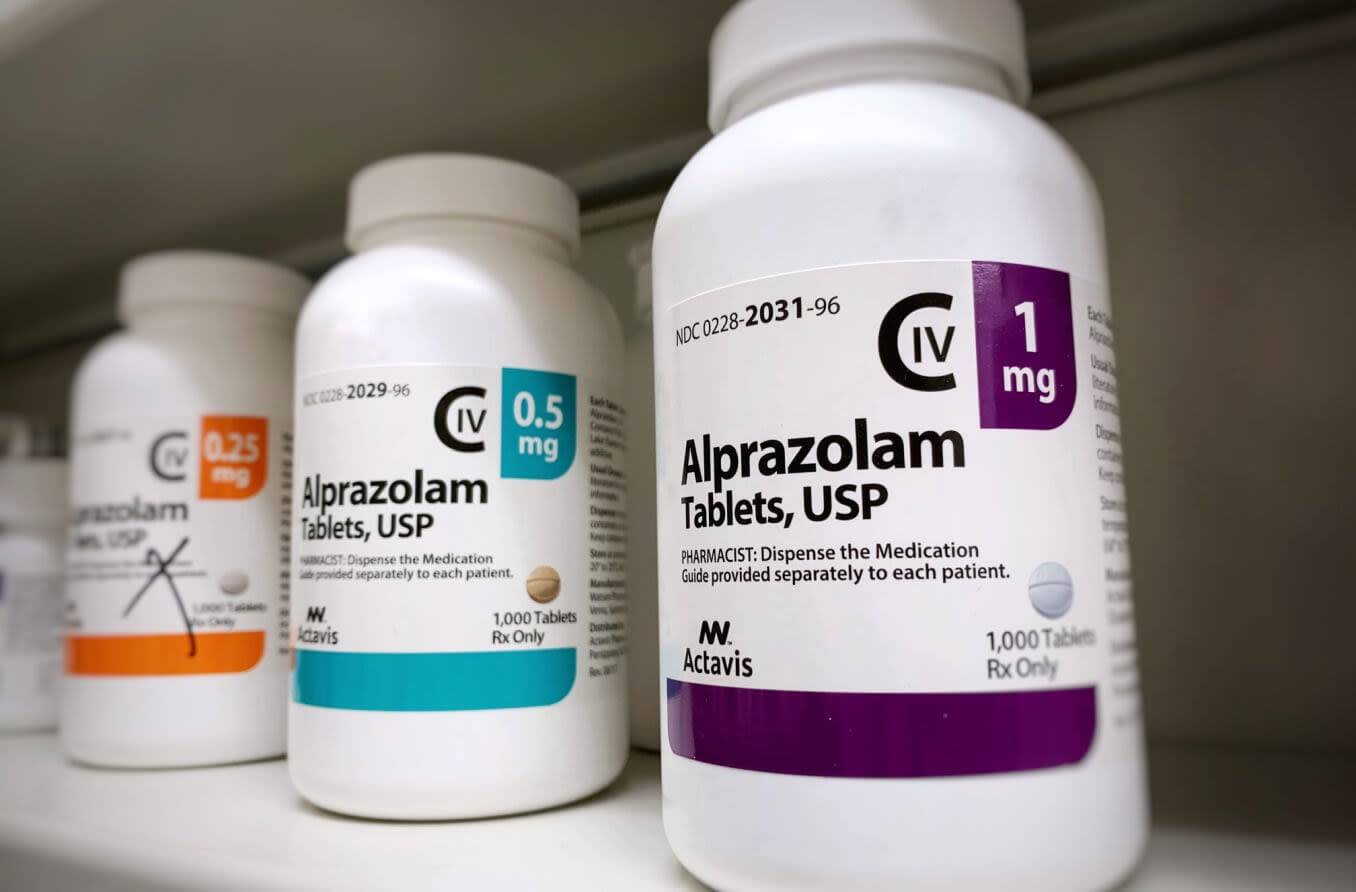Anti-anxiety medicines and your eyes
Anxiety disorders are the most common mental health issues in the country. Symptoms include panic, fear and worry, which may be managed with anti-anxiety drugs. These drugs can have eye-related side effects, such as dry eye, blurry vision, dilated pupils and difficulty focusing up close.
Each class of anti-anxiety drugs has a different mechanism of action, and potential side effects on the eye can vary accordingly. There are a few different drug classes of the most common anti-anxiety medications:
Selective serotonin reuptake inhibitors (SSRIs) and serotonin norepinephrine reuptake inhibitors (SNRIs)
Benzodiazepines
Beta-blockers
Azipirones
Anti-anxiety medications can have side effects that impact all systems of the body. This article focuses only on the eye-related side effects, so it is critical to remember that other side effects besides those listed below can also occur.
It is also important to note that everyone experiences different side effects to varying degrees. If you are experiencing any discomfort after taking an anti-anxiety medication, it is important to speak with your doctor.
What are anxiety disorders?
Anxiety disorders occur when a person experiences more than normal, temporary anxiety. The feelings of anxiety continue or get worse over time, and the symptoms interfere with normal life.
Symptoms of anxiety can be both emotional and physical, such as:
Feelings of dread
Feeling irritable and nervous
Feeling tense or apprehensive
Anticipating danger or worst-case scenarios
Fast heartbeat, shallow breathing and sweating
Difficulty sleeping
Headaches and stomach upset
Feeling exhausted
There are several types of anxiety disorders. Some major categories include:
Generalized anxiety disorder (GAD) – Chronic, constant anxiety that impacts daily life
Social anxiety disorder – Extreme and debilitating fear about social interactions
Panic disorder – Frequent and sudden episodes of intense panic
Phobias – Chronic, irrational fear of a situation or an object
People who have chronic conditions like glaucoma, AMD, diabetes or Alzheimer’s disease should consult with their doctor regarding eye-related side effects of anti-anxiety medications. The impact of a medication can vary, and individuals with these conditions may be at higher risk for serious complications of side effects.
Although the most common side effects are discussed below, a medication may cause an uncommon side effect. While taking these medications, routine exams and follow-ups are important to monitor your eye and general health.
SSRIs and SNRIs: Celexa, Lexapro, Zoloft, Prozac and Paxil eye-related side effects
Medications that are classified as SSRIs and SNRIs work by increasing the levels of serotonin in the brain. These drugs prevent the reuptake, or reabsorption, of serotonin. Serotonin is a chemical messenger between the brain’s nerve cells and the rest of your body. This chemical is important in regulating mood. Increasing the serotonin levels in the brain can help relieve symptoms of anxiety.
The following medicines are in the SSRIs and SNRIs class of drugs:
Prozac (fluoxetine)
Zoloft (sertraline)
Luvox (fluvoxamine)
Paxil (paroxetine)
Celexa (citalopram)
Lexapro (escitalopram)
Cymbalta (duloxetine)
Pristiq (desvenlafaxine)
Effexor (venlafaxine)
Dry eyes
SSRIs and SNRIs can cause symptoms of dryness in the eyes. Studies have proposed that this is due to the breakdown of the outer surface layer of the eye. Some people may find that their eyes burn, itch or feel like there is something in them. The eyes can also become red and sensitive to light. In some cases, the dryness and irritation will cause the tear glands to overproduce watery tears, and excessive tear production can result.
READ MORE: Dry eyes: Symptoms and causes
Dilated pupils and difficulty focusing
Medications in this category can also cause blurred vision and difficulty focusing up close. This occurs because of the drug’s effect on the pupil and eye muscles responsible for helping you see close up.
The sphincter pupillae muscle, which makes the pupil smaller in bright light and when you focus up close, is relaxed by serotonin. Since SSRIs and SNRIs increase the level of serotonin, these medications make the pupil larger (mydriasis) and make it more difficult for your eyes to accommodate or focus.
Higher risk of acute angle closure glaucoma and increased eye pressure
People with a narrow drainage angle — where fluid circulating in the front of the eye drains — are at an increased risk of an acute angle closure glaucoma attack. This means that the pressure in the eye can increase to unsafe levels and cause damage to the optic nerve, which connects the eye and the brain. This type of damage can lead to long-term vision loss.
Other possible side effects
Some studies have found an association between this class of medication and an increased risk of cataracts. However, the results may have been impacted by other factors, such as family history, smoking, sunlight exposure and steroid use. Additional research is ongoing to determine the extent of this association.
Some studies have found a reduction in the risk of primary open-angle glaucoma, the most common form of glaucoma, in people using SSRIs.
Rare side effects
The side effects of a medication are unique to each individual. Some people will have rare side effects, such as:
Involuntary eye muscle contractions and eye twitching
Involuntary spasms causing both eyes to roll upward
Damage to the nerve that connects the eye and brain (optic neuropathy)
Damage to the part of the eye that is responsible for fine details (maculopathy)
Loss of eyelashes
Involuntary eye movements (nystagmus)
Periorbital edema (swelling around the eyes) with Prozac
When do side effects occur?
The drugs in this class can take a few weeks to have an impact. You may not experience the side effects until a few weeks or months after beginning the medication.
Benzodiazepines: Klonopin, Xanax, Valium and Ativan eye-related side effects
Benzodiazepines are a class of medications that decrease anxiety by slowing the activity in your nervous system. They can have some sedative effects. These medicines enhance the effect of gamma-aminobutyric acid (GABA), a chemical messenger that inhibits anxiety in the brain.
Benzodiazepines are regulated substances. While benzodiazepines are generally safe, they can have eye-related side effects.
Xanax (alprazolam) is one of the most commonly prescribed benzodiazepine medicines in the United States. The following medicines are also benzodiazepines:
Valium (diazepam)
Klonopin (clonazepam)
Ativan (lorazapam)
Dry eyes
Benzodiazepines are associated with dry eye and dry mouth. This is because they block a compound called acetylcholine, resulting in decreased moisture in the eyes and mouth. Dry eye can cause additional symptoms, such as:
Blurred vision
Eye redness
Itching
Eye discomfort
Light sensitivity
Tearing
Blurry vision
Benzodiazepines can cause blurry vision by inducing dry eyes and pupil dilation. The tear film helps to keep vision clear. When the tear film is not stable, vision can fluctuate. When the pupil is dilated, vision can also decrease. A larger pupil can also cause glare sensitivity.
Increased risk of acute angle closure in both eyes
Drugs in this class have been linked to a higher risk of a sudden angle closure attack in both eyes. Like, SSRIs and SNRIs, benzodiazepines make the pupil larger. A larger pupil can cause the drainage angle to become narrower — limiting the outflow of fluid circulating in the front of the eye and increasing the risk of angle closure.
READ MORE: Glaucoma: Types, causes, symptoms and treatment
Rare side effects
Difficulty tracking objects and double vision can be a rare side effect of benzodiazepines. This may occur when the medication is used in high doses for an extended period of time.
Beta-blockers: Inderal and Tenormin eye-related side effects
Although beta-blockers are intended for the heart, they are sometimes prescribed off-label for anxiety. A doctor may give this medication to help ease anxiety during certain high-stress situations, such as public speaking. They are thought to decrease the symptoms of the body’s “fight-or-flight” response, such as sweating, jitters and fast heart rate.
The following medicines are beta-blockers:
Inderal (propranolol)
Tenormin (atenolol)
Beta-blockers can cause dry eye by impacting the production of tears. Eye-related side effects include blurry vision and the symptoms caused by an unstable tear film.
Azipirones: BuSpar eye-related side effects
Azapirones act on the 5-HT1A serotonin receptor. These medications treat anxiety by balancing the levels of chemical messengers in the brain — dopamine and serotonin. BuSpar (buspirone) is sometimes given to treat generalized anxiety disorder (GAD). It is considered a second-line treatment when someone does not respond fully to SSRIs.
A common eye-related side effect of an azipirone such as BuSpar is blurry vision. This is seen in 1% to 10% of people.
This medication can cause uncommon eye-related side effects (seen in 0.1% to 1% of people) or very rare ones (occurring in less than 0.01%). These include:
Eye redness
Development of pink eye due to irritation
Eye itching
Light sensitivity
Eye pain and pressure
Changes in vision, such as narrowing of the visual field
When to see a doctor
Routine, comprehensive eye exams are important to maintaining eye and overall health. This is particularly important if you are taking a medication long-term, such as an anti-anxiety drug.
If you have been prescribed anti-anxiety medications, changes to your regimen should only be made if you have consulted your doctor. Discuss any eye-related side effects you are having with your health professional. An adjustment to your medication should only be made under the direction of your doctor, as this can have consequences for your mental and emotional well-being.
READ MORE: Xerophthalmia disease: Symptoms, causes and treatment






